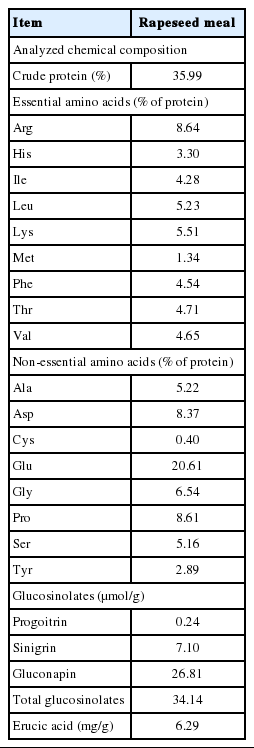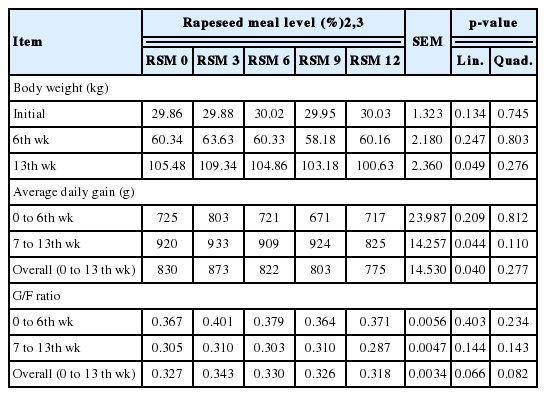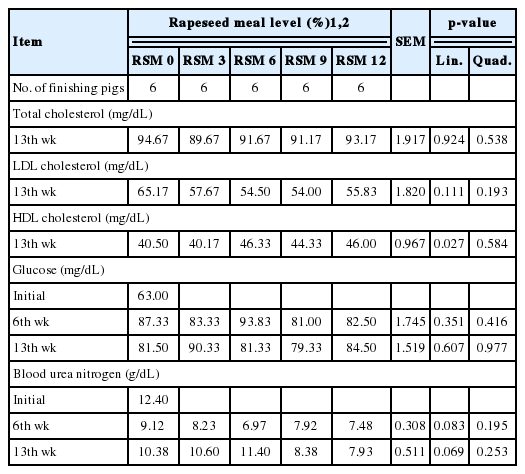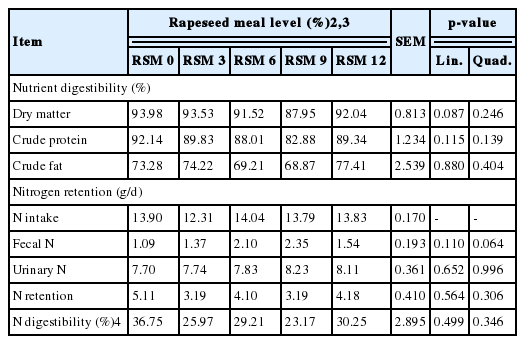Influence of Rapeseed Meal on Growth Performance, Blood Profiles, Nutrient Digestibility and Economic Benefit of Growing-finishing Pigs
Article information
Abstract
This study was conducted to investigate the influence of dietary rapeseed meal (RSM) on growth performance, blood profiles, nutrient digestibility and economic benefit of growing-finishing pigs. A total of 120 growing pigs ([Yorkshire×Landrace] ×Duroc) with an initial body weight (BW) 29.94±0.06 kg were used in this experiment. Pigs were randomly allotted into 1 of 5 treatments in a randomized complete block design and 6 replicates with 4 pigs per pen. Treatments were divided by dietary RSM supplementation levels (0%, 3%, 6%, 9%, or 12%) in growing-finishing diets. A linear decrease (p<0.05) of BW and average daily gain (ADG) were observed at 13th wk of finishing and overall periods of pigs. Additionally, gain-to-feed ratio (G/F) tended to decrease by dietary RSM supplementation in growing-finishing diets (linear, p = 0.07 and quadratic, p = 0.08). Concentrations of serum triiodothyronine and thyroxine were not influenced by dietary RSM treatments whereas thyroid gland and liver weight were increased at 13th wk of finishing period (linear, p<0.05; p<0.01) by increasing dietary RSM supplementation level. In blood profiles, serum total cholesterol and low density lipoprotein cholesterol concentrations were not differed by dietary treatments at 13th wk of finishing period whereas concentration of serum high density lipoprotein cholesterol was affected by the supplementation level of RSM, resulting in a linear RSM level responses (p<0.05). Serum blood urea nitrogen concentration tended to decrease (linear, p = 0.07; p = 0.08) at 6th wk of growing and 13th wk of finishing periods and digestibility of dry matter tended to decrease by dietary RSM (linear, p = 0.09). Crude protein, crude fat and nitrogen retention, whereas, were not affected by dietary RSM supplementation level. In the economic analysis, feed cost per weight gain was numerically decreased when RSM was provided up to 9%. Consequently, RSM could be supplemented to growing-finishing diets up to 9% (3.07 μmol/g Gls) without detrimental effects on growth performance of growing-finishing pigs.
INTRODUCTION
The cost of pig production is mainly affected by feed cost which impacts pork producers’ profitability. Soybean meal (SBM) is the most widely used protein source throughout the world whereas increasing dietary supplementation level of SBM caused an increase feed cost in pig diets (Patrick et al., 2010; Smit et al., 2014). Rapeseed meal (RSM) is a by-product of rapeseed after removal of oil and is cost effective protein source in pig diets and also alternative ingredient to SBM (Quiniou et al., 2012).
Rapeseed meal is generally contained 33% to 40% protein. The RSM has lower lysine (5.5% vs 6.2% of protein) but higher methionine (2.1% vs 1.4% of protein) and cystine (1.2% vs 0.6% of protein) compares with SBM (Bell, 1984). However, RSM has higher crude fiber (14.1% vs 3.9%) than that of SBM which means RSM contains higher neutral detergent fiber (NDF). High NDF in RSM reduces apparently ileal digestibility of lysine (74% vs 87%) and lowers protein digestibility (75% vs 90%) compared to SBM (Bell, 1984; Noblet and Goff, 2001) so nutrient digestibility may be attributed to elevated levels of fibers components (Patrick et al., 2010). Moreover, limited amount of RSM has been used in swine diets because of anti-nutritional factors such as glucosinolates (Gls) and erucic acid (Mawson et al., 1993a).
Hydrolysis products of Gls are toxic and may resulted in poor growth performance, enlarged thyroid gland, and reducing of circulating thyroid hormones (Mawson et al., 1994; Schöne et al., 1997). In addition, voluntary feed intake could be affected by inclusion of RSM in the diets because of decreased feed consumption due to high content of erucic acid, bitter taste of sinapine, and astringent effect in the mouth by tannin (Mawson et al., 1993b; Food Standards Australia New Zealand, 2003). Tripathi and Mishra (2007) demonstrated poor feed intake and reduced growth performance of pigs were observed when pigs were fed 1.3 to 2.8 μmol/g Gls diets. Therefore, the present study was conducted to determine the influence of dietary RSM levels in swine diets on growth performance, blood profiles, nutrient digestibility and economic benefit of growing-finishing pigs.
MATERIALS AND METHODS
Animal management, experimental diets and housing
A total of 120 growing pigs ([Yorkshire×Landrace]×Duroc; 29.94±0.06 kg initial body weight [BW]) were used in a 13 wk growth trial, at a research farm located in Suwon, South Korea. The pigs were allotted into five treatment groups based on their initial BW and sex with 6 replicates according to randomized completely block design. Five experimental diets containing different levels of RSM (0, 3%, 6%, 9%, or 12%) were provided to pigs during growing (0 to 6th wk) and finishing (7th to 13th wk) periods. Each diet in growing period contained 3,250 kcal of ME/kg, 14.0% of crude protein (CP) and 0.86% of total lysine and the assigned levels of RSM, respectively. The finishing period diet contained 3,261 kcal of ME/kg, 11.49% of CP and 0.68% of total lysine. The RSM, used in current experiment, was imported from India. Solvent extract of the RSM (Table 1) was supplemented to the diets with replacement of corn, SBM, and soy oil. This RSM was solvent extracted by hexane to remove the remaining oil and then desolventing toasted at 90°C to 100°C. All nutrients were met or exceeded NRC (1998) nutrient requirement estimates. The formula and chemical composition of experimental diets are presented in Tables 2 and 3.
All pigs were housed in an environmentally controlled building with half-slotted concrete floors in growing period (1.26×2.55 m2) and finishing period (1.60×3.00 m2). Each pen equipped with a feeder and a nipple drinker to provide water and mash feed ad-libitum during growing-finishing periods Body weight and feed intake were recorded at 0, 6, and 13 wks to calculate the average daily gain (ADG), average daily feed intake (ADFI) and gain-to-feed ratio (G/F ratio).
Sample collections and analysis
Blood samples were collected from 6 pigs from each treatment and were obtained via anterior vena cava at 6th wk of growing period and 13th wk of finishing period, respectively. Blood samples were centrifuged at 1,700 g at 4°C for 15 min (Eppendorf centrifuge 5810R, Hamburg, Germany) to separate serum. All samples of sera were stored at −20°C until analysis.
Rapeseed meal, fecal and urinary samples were analyzed for dry matter (967.03; AOAC, 1990), CP (976.05; AOAC, 1990), ether extract (920.39; AOAC, 1990) and crude ash (942.05; AOAC, 1990).
Estimation of amino acid content in RSM was carried out according to Moore (1963) and AccQ-Tag regent kits were used (Waters, Milford, MA, USA). Performic acid was used in oxidizing amino acids and neutralized with sodium citrate dihydrate, and then hydrolyzed with 6 N HCl for 24 h at 110°C to be liberated from the protein. Amino acids were analyzed on HPLC (Waters 486, USA). All separations were generated on NOVA-Pak C18 (4 μm) column (Waters, USA) with temperature controlled at 37°C and operated with flow rate of 1 mL/min.
Glucosinolates were extracted from RSM with 2 mL of boiling methanol solution (70% vol/vol) and 200 μL internal standard spike solution of glucotropaeolin (ChromaDex, Irvine, CA, USA) was added immediately (International Standards Organization, 1992) and extracted Gls were purified on aDEAE Sephadex A-25 anion exchange column (St. Louis, MO, USA). Three types of Gls in RSM were determined by using High Performance Liquid Chromatography (HPLC; Sunnyvale, CA, USA). Desulfo-glucosinolates were separated using a Synergi Fusion-RP 80A (100×3 mm, 4 um, Phenomenex, CA, USA) with a flow rate of 1 mL/min. Glucosinolates (progoitrin, sinigrin and gluconapin) were confirmed by a Finnigan LCQ Deca XP plus Ion Trap Mass Spectrometer system (Thermo Finnigan, CA, USA) which confirmed by LC-ESI-MS in positive mode.
Erucic acid content in RSM was analyzed on a 7890 Agilent Gas Liquid Chromatograph (Agilent Technologies, Palo Alto, CA, USA) and equipped with flame ionization detector and the column was SP-2560 (i.d. 100 m×0.25 mm ×0.20 μm film). Nitrogen was used as carrier gas, injector core temperature was 250°C, detector temperature was 260°C and column temperature was programmed to begin at 170°C and then increase to 250°C then remained at 240°C for 40 min. Chromatography was calibrated with a mixture of 37 different fatty acids (FAME 37; Supelco Inc., Bellefonte, PA, USA) and the standard contained fatty acids ranging from C4:0 to C24:1n9 and samples were added 250 μl of internal standard spike solution (Pentadecanoic acid; Sigma) by the method of AOAC (1990).
Serum triiodothyronine (T3) and thyroxine (T4) concentrations were measured by electrochemiluminescence immunoassay (T3 and T4 Kits, Roche, Mannheim, Germany). Serum total cholesterol, low density lipoprotein (LDL) cholesterol and high density lipoprotein (HDL) cholesterol concentrations were analyzed using enzymatic colorimetric assay (Cholesterol Kit; LDL-C plus 2nd generation Kit; HDL-C plus 3nd generation Kit, Roche, Mannheim, Germany). Serum glucose and blood urea nitrogen (BUN) concentrations were analyzed using a kinetic UV assay (Glucose Hexokinase Kit; UREA/BUN Kit, Roche, Mannheim, Germany).
Metabolic trial
A total of 20 pigs ([Yorkshire×Landrace]×Duroc) with an initial BW 31.14±0.36 were allotted to five treatments in a completely randomized design. Each pig was housed in an individual metabolic crate in a room of steady temperature (27°C), controlled with a heating lamp. The experimental diets were supplied twice a day at 07:00 h and 19:00 h according to the rate of 2.0 times of the maintenance requirement for ME (NRC, 1998) based on initial BW of pigs. Water was provided ad libitum. After 6 days adaptation period, pigs were subjected to 5 days collection and 0.5 g of chromic oxide and 0.5 g of ferric oxide were used as initial and end marker, respectively. Collected excreta were stored at −20°C during the collection period and dried (65°C, 72 h) and ground (2 mm screen, Wiley mill) for chemical analysis at the end of trial.
Economic analysis
Economic analysis was conducted to compare the feed cost for 1 kg weight gain. The feed cost per weight gain was calculated based on price of raw materials during the time of the experiment (May, 2013). In each phase, index was calculated from the relative ratio of the feed cost per weight gain to RSM 0 treatment.
Statistical analysis
Data were analyzed by analysis of variance for a completely randomized design using the general linear model procedure of SAS (SAS Institute, 2009). Least squares means were calculated for each independent variable. Orthogonal polynomial contrasts were used to determine linear and quadratic effects by increasing dietary RSM levels in gestation for all measurements of growing pigs. Individual animals were used as the experimental unit. Alpha level used for the determination of significance for all analysis was 0.05 and tendency for all analysis was p>0.05 and p<0.10.
RESULTS
Rapeseed meal used in this study contained progoitrin (0.24 μmol/g), sinigrin (7.10 μmol/g) and gluconapin (26.81 μmol/g), which resulted in 34.14 μmol/g of total Gls (Table 1). The erucic acid content in RSM was 6.29 mg/g of dry matter (DM) basis. Additionally, RSM, used in current experiment, contained 0.37 μmol/g of progoitrin, 11.03 μmol/g of sinigrin and 40.04 μmol/g of gluconapin which resulted in 51.44 μmol/g of total Gls and 4.53 mg/g of erucic acid DM basis (Table 4).

Glucosinolates (Gls, μmole/g) and erucic acid (mg/g) contents of eight different rapeseed meal (RSM) imported from India (dry matter basis)
Body weight and ADG at 6th wk of growing period were not affected by dietary RSM supplementation levels whereas at 13th wk of finishing and overall periods BW and ADG were decreased (linear, p<0.05) by increasing dietary RSM supplementation levels in the growing-finishing diets (Table 5). Additionally, G/F ratio tended to decrease with increased dietary RSM supplementation levels during overall period (linear, p = 0.07 and quadratic; 0.08; Table 5). However, the pigs fed diets containing RSM levels showed no difference in BW and ADG of growing-finishing pigs compared to RSM 0 treatment.
Glucosinolates content in experimental diets was equivalent to 0, 1.02, 2.04, 3.07, or 4.09 μmol/g and erucic acid content was equivalent to 0, 0.18, 0.37, 0.56, or 0.70 mg/g for 0%, 3%, 6%, 9%, or 12% of RSM supplementation groups, respectively (Table 6). Average daily feed intake was not affected by dietary RSM supplementation levels (Table 6).
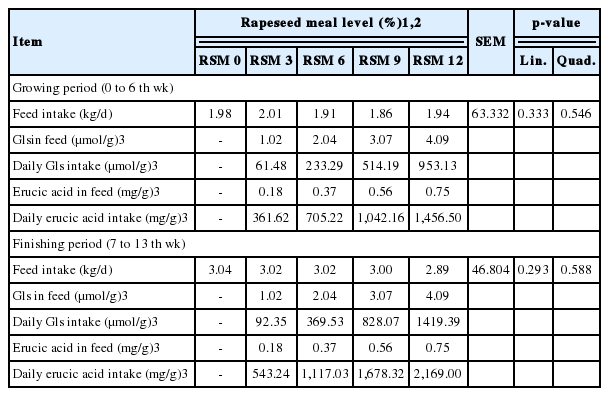
Influence of dietary rapeseed meal (RSM) on ingested glucosinolates (Gls) and erucic acid of growing-finishing pigs
As dietary RSM level of finishing diet was increased, serum T3 and T4 concentrations at 13th wk of finishing pigs were not affected among dietary RSM treatments (Table 7) whereas thyroid gland (linear, p<0.05; Figure 1) and liver (linear, p<0.01; Table 2) weight were increased by increasing dietary RSM supplementation levels at 13th wk of finishing pigs. Additionally, when pigs were fed diets containing 12% RSM showed higher liver weight at 13th wk of finishing pigs compared to control diet (p<0.01; Figure 2).

Influence of dietary rapeseed meal (RSM) on concentrations of serum triiodithyronine (T3) and thyroxine (T4) in finishing pigs
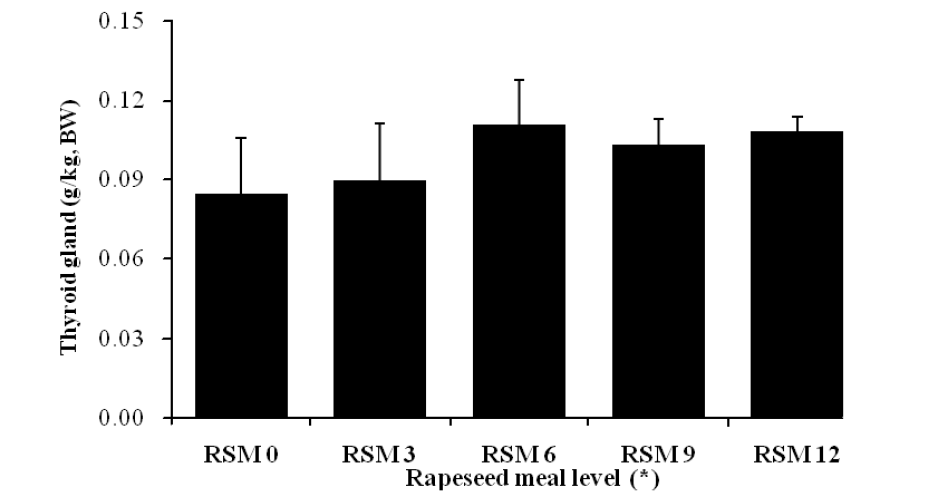
Influence of dietary rapeseed meal (RSM) utilization on thyroid gland weight at 13th wk of finishing pigs (* linear, p<0.05).

Influence of dietary rapeseed meal (RSM) utilization on liver weight at 13th wk of finishing pigs (* linear, p<0.01). A,B,C means with different superscripts within the same row significantly differ (p<0.01).
Serum HDL cholesterol concentration at 13th wk of finishing period was increased as the dietary RSM supplementation levels increased (linear, p<0.05; Table 8) whereas concentrations of serum total cholesterol and LDL cholesterol were not influenced by the dietary RSM supplementation in growing-finishing diets. Serum glucose concentration was not affected by the dietary RSM supplementation (Table 8).
In nutrient digestibility, the apparent total tract digestibility of dry matter tended to decrease when dietary RSM supplementation level was increased (linear = 0.09) whereas crude protein and crude fat were not affected by dietary RSM treatments. Fecal nitrogen tended to increase when 6% or 9% RSM was supplemented (quadratic, p = 0.06) whereas nitrogen retention and nitrogen digestibility were not influenced by dietary RSM supplementation (Table 9). Therefore, dietary RSM supplementation up to 9% had no detrimental effects on nutrient digestibility and nitrogen retention in growing-finishing pigs.
Economic benefit was calculated by feed cost per weight gain (Table 10). The feed cost was numerically decreased when dietary RSM was supplemented during overall experimental period.
DICUSSION
A high level of Gls in the in the pig diet containing RSM resulted in poor growth performance when pigs were fed 1.3 to 2.8 μmol/g Gls (Bowland, 1975; Bell et al., 1991; Tripathi and Mishra, 2007). In the results of the current study, BW, ADG, and G/F ratio were affected by dietary RSM supplementation levels up to 12% (4.09 μmol/g Gls) in growing-finishing diets. Therefore, the result of the current study indicated that RSM supplementation in growing-finishing diets did not reduce growth performance when pigs were fed 9% of RSM or 3.07 μmol/g Gls was supplemented diet during growing-finishing periods.
When pigs were fed a RSM containing diet, thyroid gland and liver weight were increased at 13th wk finishing pigs. Additionally, pigs fed diets containing 12% of RSM showed higher liver weight at 13th wk of finishing pigs compared to control diet. Increased thyroid gland and liver weight were associated with Gls breakdown product of nitriles (Mawson et al., 1994a). McKinnon and Bowland (1979) demonstrated that increased liver weight was observed when 2.0 to 4.0 μmol/g Gls were supplemented in pig diets.
The hydrolysis products of Gls are strongly related to goitrogenic substance subsequently interfere with iodine uptake and inhibit the synthesis of thyroid hormones T3 and T4 (Christison and Laarveld, 1981; Mawson et al., 1994; Schöne et al., 1997). Mawson et al. (1994) reported that thyroid function observed in pigs fed high Gls RSM induced iodine deficiency which increased the serum T3 and T4 levels and liver weight because of Gls related iodine antagonistic effects. However, in this present experiment, there were no significant differences between control and dietary RSM supplementation treatments in the serum concentrations of T3 and T4. Serum total cholesterol and LDL cholesterol concentrations were not changed by RSM supplementation but serum HDL cholesterol concentration was increased. High intake of monounsaturated fatty acid resulted in increasing HDL cholesterol levels without changing LDL cholesterol levels (Jenkins et al., 2010). Additionally, it is known that RSM contained higher amount of monounsaturated (52.0% vs 23.0% of the total fatty acid) than saturated (12.9% vs 14.2% of the total fatty acid) or polyunsaturated (33.0% vs 58.0% of the total fatty acid) fatty acids compared with SBM (Kracht et al., 2004; NRC, 2012).
Rapeseed meal has anti-nutritional factors such as tannins and phytic acid which reduces protein and amino acid digestion. Generally RSM has lower amino acid digestibility (87.0% vs 90.4%) than that of SBM (Bell, 1984; Green and Kiener, 1989). The fiber of rapeseed hulls decreased ileal digestibility of pigs and the high level of cell wall components in RSM reduces of protein availability. Also the decreased in N retention may reflect the reduced N digestibility coupled with reduced N intake with increasing dietary RSM levels (Patric et al., 2010).
Sauer et al. (1982) also indicated that the true ileal availabilities of amino acid were lower in RSM than SBM. When 9% of RSM was provided to growing-finishing pigs, serum BUN concentration tended to decrease. In general, dietary lysine level was related to BUN concentration and nitrogen retention (Eggum, 1970) but nitrogen retention and nitrogen digestibility were not affected by dietary RSM supplementation.
Economic benefit was increased when 9% of RSM was supplemented in growing-finishing diets because RSM is a cost saving ingredient in pig diets (Quiniou et al., 2012).
IMPLICATIONS
Several impacts of increasing RSM levels in growing-finishing diets were observed in growth performance and organ weight; decreased BW, ADG, and G/F ratio when RSM was provided up to 12%. Increased thyroid gland as well as liver weight were observed as dietary RSM supplementation levels increased and serum HDL cholesterol concentration was increased by dietary RSM supplementation. However, RSM could be supplemented up to 9% (3.07 μmol/g Gls) in growing-finishing pig diets without any detrimental effect on growth performance.
ACKNOWLEDGMENTS
This research was supported by Nonghyup feed Inc. (Project No. 0569-20120010), Nonghyup feed Inc., Republic of Korea.
